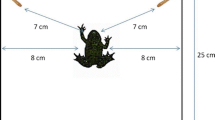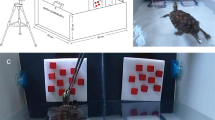Abstract
Techniques traditionally used in developmental research with infants have been widely used with nonhuman primates in the investigation of comparative cognitive abilities. Recently, researchers have shown that human infants and monkeys select the larger of two numerosities in a spontaneous forced-choice discrimination task. Here we adopt the same method to assess in a series of experiments spontaneous choice of the larger of two numerosities in a species of amphibian, red-backed salamanders (Plethodon cinereus). The findings indicate that salamanders "go for more," just like human babies and monkeys. This rudimentary capacity is a type of numerical discrimination that is spontaneously present in this amphibian.

Similar content being viewed by others
References
Feigenson L, Carey S, Hauser MD (2002) The representations underlying infants' choice of more: object files vs. analog magnitudes. Psychol Sci 13:150–156
Gillette JR, Jaeger RG, Peterson MG (2000) Social monogamy in a territorial salamander. Anim Behav 59:1241–1250
Hauser MD, Carey S (1999) Building a cognitive creature from a set of primitives: evolutionary and developmental insights. In: Allen C, Cummins D (eds) The evolution of mind. Oxford University Press, Oxford, pp 51–106
Hauser MD, MacNeilage P, Ware M (1996) Numerical representations in primates. Proc Nat Acad Sci U S A 93:1514–1517
Hauser MD, Carey S, Hauser L (2000) Spontaneous number representation in semi-free-ranging rhesus monkeys. Proc R Soc Lond B Biol Sci 267:829–833
Jaeger RG, Barnard DE (1981) Foraging tactics of a terrestrial salamander: choice of diet in structurally simple environments. Am Nat 117:639–664
Jaeger RG, Barnard DE, Joseph RG (1982) Foraging tactics of a terrestrial salamander: assessing prey density. Am Nat 119:885–890
MacArthur RH, Pianka ER (1966) On optimal use of a patchy environment. Am Nat 100:603–609
Nieder A, Freedman DJ, Miller EK (2002) Representation of the quantity of visual items in the primate prefrontal cortex. Science 297:1708–1711
Pyke GH, Pulliam HR, Charnov EL (1977) Optimal foraging: a selective review of theory and tests. Q Rev Biol 52:137–154
Santos L, Sulkowski G, Spaepen G, Hauser MD (2002) Object individuation using property/kind information in rhesus macaques (Macaca mulatta). Cognition 83:241–264
Sayler A (1966) The reproductive ecology of the red-backed salamander, Plethodon cinereus, in Maryland. Copeia 1966:183–193
Simon T, Hespos S, Rochat P (1995) Do infants understand simple arithmetic? A replication of Wynn (1992). Cogn Dev 10:253–269
Stephens DW, Krebs JR (1986) Foraging theory. Princeton University Press, Princeton, N.J.
Sulkowski G, Hauser MD (2001) Can rhesus monkeys spontaneously subtract? Cognition 79:239–262
Treisman A, Gelade G (1980) A feature-integration theory of attention. Cogn Psychol 12:97–136
Trick L, Pylyshyn Z (1994) Why are small and large numbers enumerated differently? A limited capacity preattentive stage in vision. Psychol Rev 101:80–102
Uller C (1996) Origins of numerical concepts. A comparative study of human infants and nonhuman primates. Unpublished doctoral dissertation, Massachusetts Institute of Technology, Cambridge, Mass.
Uller C, Carey S, Hauser MD (1997) Is language needed for constructing sortal concepts? A study with nonhuman primates. Proceedings of the 21st annual Boston University conference on language development. Cascadilla Press, Somerville, Mass., pp 665–677
Uller C, Carey S, Huntley-Fenner G, Klatt L (1999) What representations might underlie infant numerical knowledge. Cogn Dev 14:1-36
Uller C, Hauser, MD, Carey S (2001) Spontaneous representation of number in cotton-top tamarins. J Comp Psychol 115:1–10
Whalen J, Gallistel CR, Gelman R (1999) Nonverbal counting in humans: the psychophysics of number representation. Psychol Sci 10:130–137
Wynn K (1992) Addition and subtraction by human infants. Nature 258:749–750
Acknowledgements
We thank Henry Wilbar for permission to use the facilities at Mountain Lake Biological Station; Don Dedrick, Mike Kalish, and Tony Maida for comments on an earlier version of this manuscript; Danielle Lee for assistance with the experiments; Tom Dickins and Uri Leron for comments on a presentation at the 2002 HBES conference based on these experiments, and three anonymous reviewers for comments on the previously submitted draft. The experiments described here comply with the current laws for animal care and use of the United States and were approved by the Animal Care and Use Committee of the University of Louisiana at Lafayette (IACUC no. 2001-8717-004).
Author information
Authors and Affiliations
Corresponding author
Rights and permissions
About this article
Cite this article
Uller, C., Jaeger, R., Guidry, G. et al. Salamanders (Plethodon cinereus) go for more: rudiments of number in an amphibian. Anim Cogn 6, 105–112 (2003). https://doi.org/10.1007/s10071-003-0167-x
Received:
Revised:
Accepted:
Published:
Issue Date:
DOI: https://doi.org/10.1007/s10071-003-0167-x




